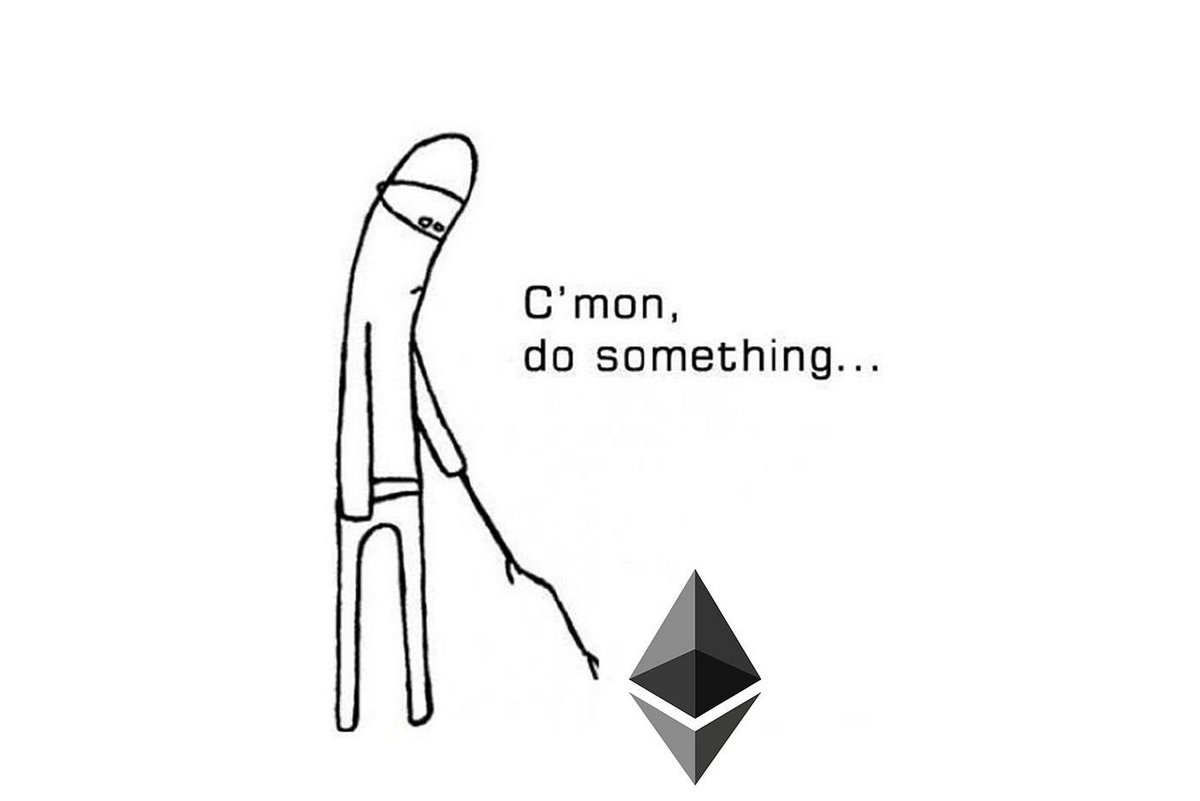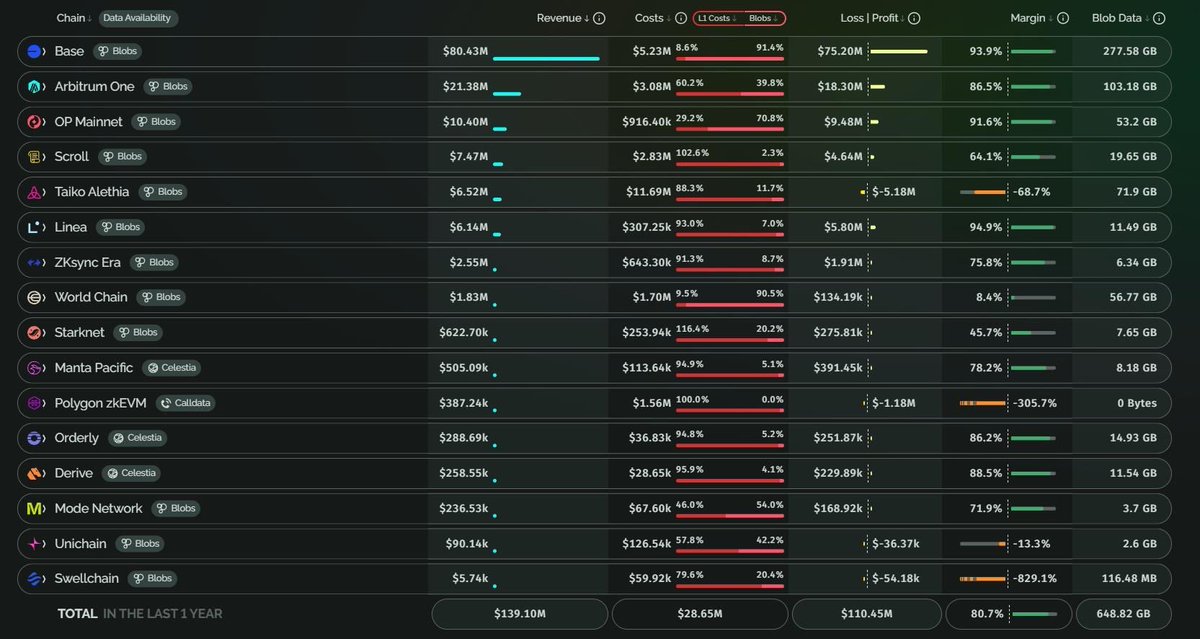The challenge with Ethereum’s economics today is that $ETH is losing ground on two fronts currently
Ultrasound Money (Revenue):
L1 revenue has been deteriorating due to Ethereum forfeiting the most valuable part of the stack (congestion gas pricing fees + MEV) to L2s, while optimizing for the least valuable part of the stack (settlement + DA), as seen in the 90%+ profit margins of L2s
In parallel, applications are increasingly recapturing their own MEV rather than letting it leak to L1 blockchain validators (e.g., Aave using Chainlink SVR to recapture liquidation MEV + apps launching their own app chains / L2s like Uniswap)
As Ethereum continues to scale blobspace for L2s and scale the L1, transaction fees become a race to the bottom in terms of marginal cost, while apps continue to capture more of the revenue pie
Ethereum doesn’t exist in isolation, it has to compete with other alt L1s (and L2s) on speed and cost, which push down revenue if demand doesn’t scale up as well, at least for the foreseeable future
Ethereum needs absolutely insane amounts of onchain volume/activity for its economics to make sense in terms of revenue at scale, or get back to where it was in 2021, and how much will L2s and apps make in comparison in that world?
Programmable Money (SoV):
Gas tokens are being abstracted away in the background via account abstraction and paymaster solutions, any form of value can be used to pay for any services (incl gas), nobody will need to hold surplus reserves of ETH for gas on any network or even know the asset exists
L2s don’t just scale access to ETH, they scale access to every asset issued on Ethereum, ETH therefore has to compete with every other form of value on its network
And by bridging ETH to a trusted/centralized L2, that ETH ends up having the same exact trust assumptions as every other assets bridged over, negating much of its ‘censorship-resistant SoV’ advantages
USD Stablecoins have been the clear PMF of crypto and more and more crypto markets these days are denominated in USD, it won’t be any different when tokenized assets scale up as people want to trade against the world reserve currency
The world hasn’t changed, people don’t want to use a highly volatile cryptocurrency for day-to-day payments unless they absolutely have to, stablecoins offer a better UX and more stability for 99% of people
The best argument ETH has for this is that it’s unironically the second best crypto asset SoV, so you should diversify into it after buying BTC, not the best argument imo
That or Ethereum is able to successfully pivot to recapture a better share of the revenue pie back from L2s (e.g., based rollups), and/or have a really good ‘ETH is money’ psyops campaign
Nothing is guaranteed to work, it’s really up to you how optimistic you are on how Ethereum’s pivot will play out
Either way, a few years ago, neither of these forms of value accrual were in question, but now they are
And when you’re a rank #2 $210B asset just after BTC, yes you are held to higher standards than other cryptos, with current metrics compared to historical metrics to measure growth

@0xSton And that unique value to L2s, DA blobs, unfortunately just isn’t that valuable today
The economics of DA generally is pretty bad, increasingly commoditized and flat fee pricing (value of a blob doesn’t scale with the economic value of transactions it contains)
$ETH economics look bleak, here's some numbers from the past year
L2 networks generated ~10x more profit than Ethereum L1 generated in blob fees
L2 networks had an average 80.7% profit margin ($139M in revenue - $28.6M in L1 costs = $110.4M in L2 profits)
Ethereum L1 made only $12M in blobs fees from L2s (~$16.6M in settlement fees)
@base was the most profitable L2, with a profit margin of 93.9% ($80.4M revenue - $5.2M L1 costs = $75.2M profit), accounting for 68% of all L2 profits
Ethereum L1 charged $16.53/MB for DA blobs (708GB for $12M in fees from 31 protocols)
While @celestia charged only $0.09/MB for DA blobs (2.53TB for $234K in fees from 22 protocols)
In effect, Alt DA was 180x cheaper than Ethereum L1 blobs
Obviously these are all backward facing numbers, and the future could look completely different
But these L2 margins are not looking favorable for the L1 and altDA will only continue to get more competitive

@Cryptovalley__ I did, and these were the conclusions, which included looking at the data
$ETH economics look bleak, here's some numbers from the past year
L2 networks generated ~10x more profit than Ethereum L1 generated in blob fees
L2 networks had an average 80.7% profit margin ($139M in revenue - $28.6M in L1 costs = $110.4M in L2 profits)
Ethereum L1 made only $12M in blobs fees from L2s (~$16.6M in settlement fees)
@base was the most profitable L2, with a profit margin of 93.9% ($80.4M revenue - $5.2M L1 costs = $75.2M profit), accounting for 68% of all L2 profits
Ethereum L1 charged $16.53/MB for DA blobs (708GB for $12M in fees from 31 protocols)
While @celestia charged only $0.09/MB for DA blobs (2.53TB for $234K in fees from 22 protocols)
In effect, Alt DA was 180x cheaper than Ethereum L1 blobs
Obviously these are all backward facing numbers, and the future could look completely different
But these L2 margins are not looking favorable for the L1 and altDA will only continue to get more competitive

32.86K
237
The content on this page is provided by third parties. Unless otherwise stated, OKX is not the author of the cited article(s) and does not claim any copyright in the materials. The content is provided for informational purposes only and does not represent the views of OKX. It is not intended to be an endorsement of any kind and should not be considered investment advice or a solicitation to buy or sell digital assets. To the extent generative AI is utilized to provide summaries or other information, such AI generated content may be inaccurate or inconsistent. Please read the linked article for more details and information. OKX is not responsible for content hosted on third party sites. Digital asset holdings, including stablecoins and NFTs, involve a high degree of risk and can fluctuate greatly. You should carefully consider whether trading or holding digital assets is suitable for you in light of your financial condition.

